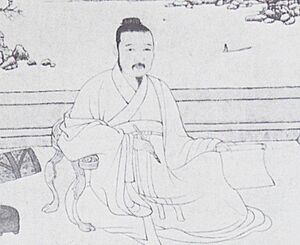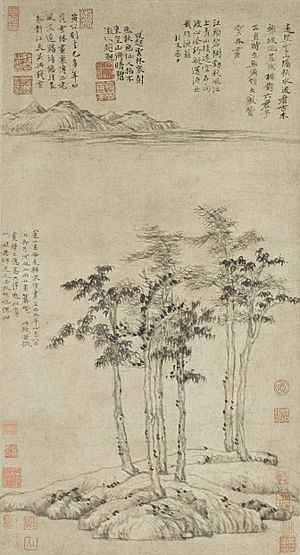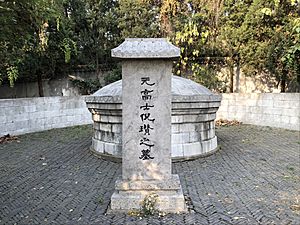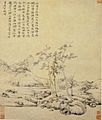Ni Zan facts for kids
Quick facts for kids Ni Zan |
|||||||||||||||||||
|---|---|---|---|---|---|---|---|---|---|---|---|---|---|---|---|---|---|---|---|
| Traditional Chinese | 倪瓚 | ||||||||||||||||||
| Simplified Chinese | 倪瓒 | ||||||||||||||||||
|
|||||||||||||||||||
Ni Zan (Chinese: 倪瓚; 1301–1374) was a very important Chinese painter. He lived during the Yuan and early Ming periods. He is known as one of the Four Masters of the Yuan Dynasty. The other three masters were Huang Gongwang, Wu Zhen, and Wang Meng.
Contents
Ni Zan's Life Story
Ni Zan was born in Wuxi, China, into a rich family. His courtesy name was Yuan Zhen. He also had art names like Yun Lin Zi and Huan Xia Sheng. He was born after Kublai Khan, a Mongol ruler, had taken over China. The Yuan rulers did not trust many traditional Chinese scholars. Instead, they often gave important jobs to Mongols and Muslims.
Education and Early Influences
Even though government jobs were hard to get, Ni Zan's wealthy family could afford a good Confucian education for him. He was part of a group of rich scholars and poets. They changed how Chinese painting was done. Their paintings showed natural places that were special to them. These artworks often reflected their personal feelings.
Facing Difficult Times
In the 1340s, many droughts and floods hit Ni Zan's area. This caused a severe famine, which led to peasant revolts. These uprisings became very strong around 1350. This was partly because the government forced people to work on repairing dikes on the Yellow River. The Yuan rulers also made rich landowners pay high taxes. This was to help pay for the costs of the natural disasters.
There are different ideas about how Ni Zan reacted to these taxes. What he did next is not fully clear. However, we know that he gave away all his belongings to his friends. Then, he moved into a houseboat. He left just before a big uprising called the Red Turban Revolt. He traveled through the peaceful southeast of China. Meanwhile, his home region was torn apart by different revolutionary groups. It was during this time that Ni Zan developed his unique painting style.
Developing His Unique Art Style
After 1345, Ni Zan's landscape paintings all looked quite similar. They were usually ink-only paintings. They showed widely separated riverbanks with simple brushwork. Trees in the front were silhouetted against a wide expanse of water. His sparse landscapes never included people. This was different from many traditional Chinese paintings.
Many of his works hardly looked like the real places they were supposed to show. Ni Zan purposely used his art to express himself. In 1364, he said, "I use bamboo painting to write out the excitement in my heart, that is all. Why should I worry whether it shows likeness or not?" This shows that for him, art was about feeling, not just copying nature.
Later Life and Famous Works
Ni Zan continued to travel around southern China as the Yuan Dynasty fell apart. He spent his time painting. During his life, his art was highly valued. It was even enough to pay for the kindness and hospitality he received from his friends as he traveled. He returned to his hometown in 1371, after the Ming Dynasty had been established. In 1372, he painted his famous Rongxi Studio. This painting is a perfect example of his special style.
Ni Zan's Paintings
-
Ni Zan, Water and Bamboo Dwelling, found in the National Museum of China.
-
Ni Zan, Trees in a River Valley in Yü shan, a private collection in New York City.
-
The Distant Cold Flow Pine, located in the Palace Museum, Beijing.
-
Bamboo, and Elegant Stone, also in the Palace Museum, Beijing.
See also
 In Spanish: Ni Zan para niños
In Spanish: Ni Zan para niños







